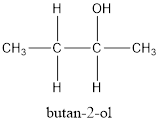
Concept explainers
(a)
Interpretation:
The structure of organic compound with 4 carbon atoms and an ester group needs to be drawn.
Concept introduction:
The organic compounds generally contain carbon atoms. The naming of organic compounds is done by considering three main terms which are prefix, suffix and the root name. The longest chain in the compound is first identified and named that will be the root name for the compound. For example, if there are 3 carbon atoms in the longest chain, the root name will be “prop”. To determine the suffix,
Explanation of Solution
According to the question, there are 4 carbon atoms in the main chain. Also, there is an ester group. The general formula of an ester is
Now, if there are 4 carbon atoms in the main chain, the structure of compound will be:

(b)
Interpretation:
The structure of organic compound with 4 carbon atoms and an aldehyde group needs to be drawn.
Concept introduction:
The organic compounds generally contain carbon atoms. The naming of organic compounds is done by considering three main terms which are prefix, suffix and the root name. The longest chain in the compound is first identified and named that will be the root name for the compound. For example, if there are 3 carbon atoms in the longest chain, the root name will be “prop”. To determine the suffix, functional group should be identified. For example, alcohol group will have suffix −ol, aldehyde will have suffix −al. If there is no functional group the suffix will be −ane. In the last step, side groups are identified and named. Prefix is used to give number of side groups and substituent’s present on the main carbon chain.
Explanation of Solution
According to the question, there are 4 carbon atoms in the main chain. Also, there is an aldehyde group. The general formula of an aldehyde is
Now, if there are 4 carbon atoms in the main chain, the structure of compound will be:

(c)
Interpretation:
The structure of organic compound with 4 carbon atoms and an ether group needs to be drawn.
Concept introduction:
The organic compounds generally contain carbon atoms. The naming of organic compounds is done by considering three main terms which are prefix, suffix and the root name. The longest chain in the compound is first identified and named that will be the root name for the compound. For example, if there are 3 carbon atoms in the longest chain, the root name will be “prop”. To determine the suffix, functional group should be identified. For example, alcohol group will have suffix −ol, aldehyde will have suffix −al. If there is no functional group the suffix will be −ane. In the last step, side groups are identified and named. Prefix is used to give number of side groups and substituent’s present on the main carbon chain.
Explanation of Solution
According to the question, there are 4 carbon atoms in the main chain. Also, there is an ether group. The general formula of ether is
Now, if there are 4 carbon atoms in the main chain, the structure of compound will be:

The other possible structure is as follows:

(d)
Interpretation:
The structure of organic compound with 4 carbon atoms and an alcohol group needs to be drawn.
Concept introduction:
The organic compounds generally contain carbon atoms. The naming of organic compounds is done by considering three main terms which are prefix, suffix and the root name. The longest chain in the compound is first identified and named that will be the root name for the compound. For example, if there are 3 carbon atoms in the longest chain, the root name will be “prop”. To determine the suffix, functional group should be identified. For example, alcohol group will have suffix −ol, aldehyde will have suffix −al. If there is no functional group the suffix will be −ane. In the last step, side groups are identified and named. Prefix is used to give number of side groups and substituent’s present on the main carbon chain.
Explanation of Solution
According to the question, there are 4 carbon atoms in the main chain. Also, there is an alcohol group. The general formula of alcohol is
Now, if there are 4 carbon atoms in the main chain, the structure of compound will be:
 or
or
The other possible structure is as follows:

Chapter 22 Solutions
Chemistry: Matter and Change
Additional Science Textbook Solutions
General, Organic, and Biological Chemistry (3rd Edition)
Chemistry: A Molecular Approach
Introductory Chemistry (6th Edition)
Organic Chemistry (8th Edition)
 ChemistryChemistryISBN:9781305957404Author:Steven S. Zumdahl, Susan A. Zumdahl, Donald J. DeCostePublisher:Cengage Learning
ChemistryChemistryISBN:9781305957404Author:Steven S. Zumdahl, Susan A. Zumdahl, Donald J. DeCostePublisher:Cengage Learning ChemistryChemistryISBN:9781259911156Author:Raymond Chang Dr., Jason Overby ProfessorPublisher:McGraw-Hill Education
ChemistryChemistryISBN:9781259911156Author:Raymond Chang Dr., Jason Overby ProfessorPublisher:McGraw-Hill Education Principles of Instrumental AnalysisChemistryISBN:9781305577213Author:Douglas A. Skoog, F. James Holler, Stanley R. CrouchPublisher:Cengage Learning
Principles of Instrumental AnalysisChemistryISBN:9781305577213Author:Douglas A. Skoog, F. James Holler, Stanley R. CrouchPublisher:Cengage Learning Organic ChemistryChemistryISBN:9780078021558Author:Janice Gorzynski Smith Dr.Publisher:McGraw-Hill Education
Organic ChemistryChemistryISBN:9780078021558Author:Janice Gorzynski Smith Dr.Publisher:McGraw-Hill Education Chemistry: Principles and ReactionsChemistryISBN:9781305079373Author:William L. Masterton, Cecile N. HurleyPublisher:Cengage Learning
Chemistry: Principles and ReactionsChemistryISBN:9781305079373Author:William L. Masterton, Cecile N. HurleyPublisher:Cengage Learning Elementary Principles of Chemical Processes, Bind...ChemistryISBN:9781118431221Author:Richard M. Felder, Ronald W. Rousseau, Lisa G. BullardPublisher:WILEY
Elementary Principles of Chemical Processes, Bind...ChemistryISBN:9781118431221Author:Richard M. Felder, Ronald W. Rousseau, Lisa G. BullardPublisher:WILEY





